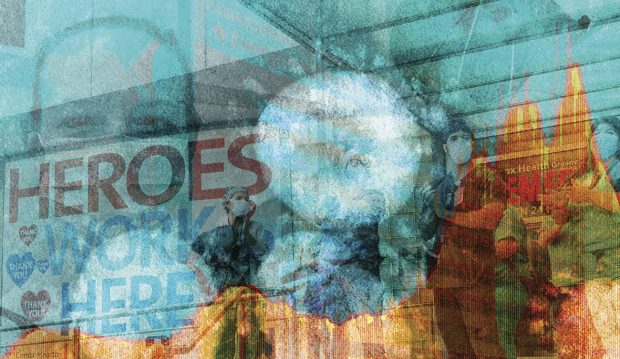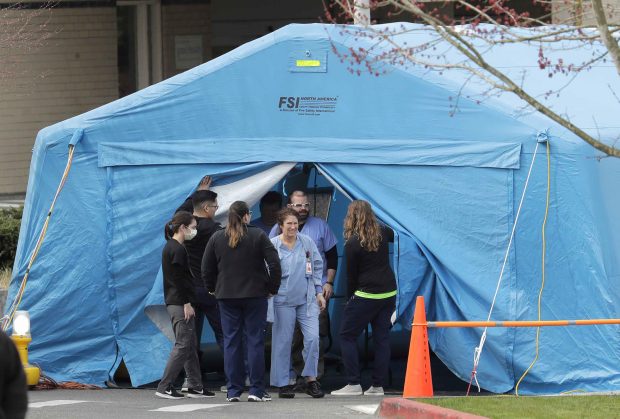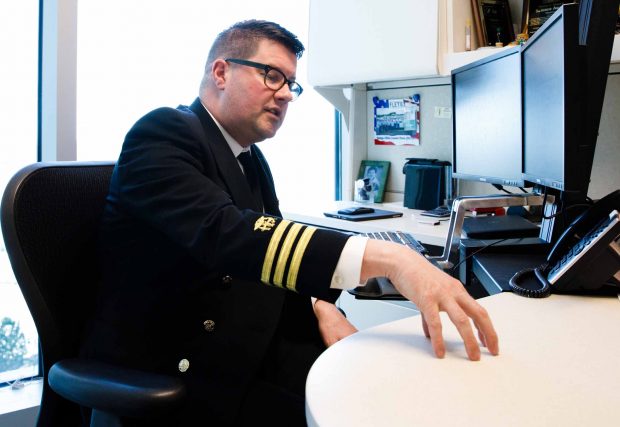
It wasn’t the end, not by a long shot, but it felt like the beginning of the end.
“I was just at home. It was a weeknight, like 8 p.m.,” says Kate Dzurilla ’11, a nurse practitioner at NYU Langone hospital in New York who worked nights on a COVID-19 floor during the surge that brought freezer trucks to the city to serve as overflow morgues. “It just popped up on my phone. ‘You have an appointment to schedule. You’re eligible for the vaccine.’”
Clicking through quickly, Dzurilla scheduled the first available slot on Dec. 15. “And I just kind of started crying,” she says. “I wasn’t sure exactly what the emotion was, whether it was excitement or relief that it was over or, like, a little bit hopeful.”
On the other side of the country in Kirkland, Washington, Dr. David Siew ’98 works as an internal medicine hospitalist at EvergreenHealth Medical Center, where the first known U.S. outbreak of COVID-19 was identified in February 2020 as patients from the nearby Life Care Center skilled nursing facility streamed into the hospital with severe lower respiratory illness. The hospital would later lose an intensive care nurse to COVID-19. “A nurse that had been with us for a really long time and was a bedrock of all of our intensive care unit,” Siew says. “That was really hard, and obviously it highlighted our own vulnerability.”
On Christmas Eve, Siew and other hospital staff received their own first vaccines.
“It was amazing to see the emotion of people,” he says. “It was almost like a party atmosphere at our vaccine clinic because of the amount of relief and elation after living a year in a higher-risk environment, just knowing that the threat was always there, that you could fall critically ill or die from this illness. Obviously, the vaccine is not 100% protective, but to finally have some relief was euphoric, and hopefully we’ll be able to get that for everyone.”

Nurse practitioner Kate Dzurilla ’11 takes a selfie as she receives her first dose of the COVID-19 vaccine.
The first known U.S. case of the novel coronavirus that causes COVID-19 was identified on Jan. 20, 2020, in Washington’s Snohomish County in a 35-year-old man who had recently returned from Wuhan, China. “Patient Zero” would recover.
At the headquarters of the Centers for Disease Control and Prevention in Atlanta, Matt Wise ’01 monitored the reports. With a Ph.D. in epidemiology from UCLA, he has worked for the CDC for more than a dozen years and has risen to chief of the Outbreak Response and Prevention Branch in the division of Foodborne, Waterborne and Environmental Diseases, typically focusing on illnesses caused by such pathogens as salmonella, E. coli and listeria.
“The reality is that almost every year, there’s some major public health disaster either at home or abroad,” he says.
Most are contained. This time was different.
The outbreak at the Life Care Center was identified after Dr. Francis Riedo, a former CDC Epidemic Intelligence Service officer and the director for infection control and prevention at the hospital where Siew works, noted an expansion in testing eligibility beyond only those who had travel history or contact with someone who was infected. The hospital selected two seriously ill patients, sent out the tests, and uncovered what would become one of the first significant COVID-19 outbreaks in the United States.
But those illnesses among vulnerable elderly patients weren’t what stopped Wise cold: At about the same time, a 17-year-old high school student from nearby Everett, Washington, tested positive with no history of travel. “The moment that came out, you knew that there was extensive unrecognized community transmission going on,” Wise says. “I think seeing that confirmed everyone’s worst fears that this was being transmitted widely within the U.S. And I think that was the moment where it was just like, ‘OK, we’re not getting out of this. This is here, and it’s happening.’”
Back in New York, the virus hit early and hard.
“I got it right at the beginning, like March 16th. I tested positive,” Dzurilla says. “Thankfully it was mild, but there was so much anxiety, more than anything. Especially at that point, we didn’t really know what all the symptoms would be like. I lost my taste and smell on about Day 5 of being sick and no one had even known that was a symptom at that time. When I got it, we’d barely had any COVID patients. When I came back two weeks later after being sick, the hospital had exploded, and it was all COVID.”
In Los Angeles, Dr. Edgar Chavez ’98 had been monitoring the distant drumbeat of the deadly virus that emerged from Wuhan for months, but Los Angeles County did not record its first death until March 11, a woman who had traveled abroad.
Chavez earned a medical degree at Stanford before turning down a lucrative job offer and returning to the South L.A. neighborhood where he grew up after his family fled war-torn El Salvador. The Universal Community Health Center he opened on E. Washington Boulevard blocks from his childhood home was the first of three clinics he founded to meet the needs of the underserved, largely Spanish-speaking population.
It was a Monday in March, as Chavez recalls, when “I had a patient that came to see me, and he was having a bad cough, just not feeling really well. He had an appointment to come back a week after so that I could evaluate him again. And by Sunday I get a call from a community hospital that he had passed away from respiratory failure. This was a young 60-year-old guy. He had a little bit of diabetes, but not really to the level that I would say, oh, my God, you know, you are at such huge risk of dying from any type of disease. And so that’s when it hit me. You know what? This is going to be really bad.”

Workers exit a large tent set up in front of the emergency room at EvergreenHealth Medical Center, where Dr. David Siew ’98 experienced the first known outbreak of COVID-19 in the United States. —AP Photo/Ted S. Warren
At the initial U.S. epicenter of the disease, doctors at EvergreenHealth started a website recording their own experiences and responses to the new disease to share with medical colleagues around the U.S., Siew says.
But after the earliest days, when COVID associated with people who had the means to travel—or had interacted with people who traveled—began to fade, it became clear that the battle is against more than the disease itself, says the CDC’s Wise.
“The virus has found the soft underbelly of everything in our society, all of our public health system, our health care system, the inequities, racism—the virus sort of sees all of that,” says Wise. He has now served three COVID deployments from his home—the first last spring focused on identifying areas where transmission was increasing rapidly, the second in the fall working on community interventions such as how to protect people at polling places, and the most recent this winter focused on providing constantly updated vaccination data on the CDC COVID Data Tracker. “When you ask that question about whether I have been touched, well, I am one of the people who have the ability to work remotely and insulate ourseves from contact.”
Working from home “is not a luxury that lots of people have. It’s not a luxury that health care providers have, and it’s not a luxury that lots of people that have to go to a physical job every day have,” Wise says.
The disparities unfolded starkly in the South L.A. communities Chavez’s clinics serve. “A lot of our population historically has gotten poor health care, so they have lots of diabetes, hypertension, heart disease,” he says. “When they get COVID, it’s not a flu, it’s not a cold. It’s actually something that drives them to the hospital. We’re seeing a lot of deaths. In the past year, I’ve probably lost upwards of 15 to 20 patients to COVID—my own patients that I’ve seen over the past 10 years that I’ve been at the clinic.
“The reason that’s happening is because a lot of our community lives in multigenerational households, and so you’ll have the young that have to go out to work. They’re the people that work in restaurants and shops, where they’re the first line to deal with the public. And they’re repeatedly being exposed to COVID. The young may not have issues; they will get over the COVID. But the problem is that they’re taking this COVID back home, and they have grandpas and parents who have these high-risk conditions and end up getting COVID, and then they end up dying. A lot of our patients are undocumented too. They don’t have the luxury of saying, ‘I am going to rely on the subsidies that the government gives for me to stay home, from unemployment.’ They don’t have access to that money. It’s a hard situation to see with our patients.”
Frustrated with waiting up to 10 days at one point for results from COVID tests sent out to labs—rendering them clinically useless, he says—Chavez made a decision to go big on testing that provides quick results. “You can tell people, ‘Hey, stay home,’ but if they don’t have a positive result, people are like, ‘Maybe I’m negative.’ They don’t really listen to you.”
With the help of $650,000 from the federal CARES Act, Chavez purchased a mobile van for testing, hired additional staff and ordered 200,000 of Abbott’s ID Now tests that provide a result in less than 15 minutes. The Universal clinics now provide three types of COVID tests—antibody, antigen and the rapid PCR test. In a typical month before the pandemic, the clinics might have had 2,000 patient visits. Now, he says, it’s 4,500 a month, in part because of access to testing.
Along with testing, Chavez transitioned many clinic visits to telephone or virtual with a simplified system called Doxy.me that allows people to simply click on a text for a video call rather than going through a portal or requiring a computer and Wi-Fi. That allowed both patients and his health care providers to limit contact.
With the arrival of the vaccine, Chavez pivoted again, quickly ordering vaccines and spending close to $10,000 on a used ultra-low-temperature freezer to store them.
Beyond L.A. County, Dr. Michael Sequeira ’73 faces some of the same demographic challenges and more in his role as San Bernardino County’s new public health officer—a job he started on Nov. 23, shortly before the devastating post-holiday surge.
The county is home to transportation and shipping hubs, farm workers, a large Indigenous population that includes the San Manuel and Morongo tribes and many Pacific Islanders, whose large and close-knit families have been hit hard by the virus.
As hospitals began to fill, Sequeira, a former emergency room doctor, stepped back in to assist in the emergency room for a bit, even though at 69 his age put him in a vulnerable group.
“Most of the hospitals in the region were bursting at the seams,” he says. “We were helping bring in State and National Guard to help our different hospitals. We were basically having to put ICU beds in gift shops and hospital cafeterias and lobbies.”
Since then, he has shifted his work to the immense logistical task of distributing vaccines in a county that covers more than 20,000 square miles and reaches to the Arizona and Nevada borders, making it the largest in the Lower 48 states.
Instead of creating vaccination mega-sites, as L.A. County did, San Bernardino adopted a hub-and-spoke system to reach a more dispersed population. Another challenge is overcoming vaccine hesitancy in the community. “I just had a feeling that was going to be a problem with this vaccine,” Sequeira says, recalling how about half of his nurses in years past had resisted flu vaccines. “From the start, I was trying to stay ahead because if we only had 50% of the people who are eligible taking the vaccine, we’d never reach herd immunity.”
To counter uncertainty stemming from concerns about the speed of the vaccine’s approval, the mRNA technology, politicization of the pandemic or other issues, San Bernardino embarked on a campaign of education and reassurance using social media, community town halls and spokespeople including Black doctors, Spanish-speaking doctors and tribal doctors.
There are also worries about variants, with the U.K. variant appearing in a small pocket of Big Bear Lake. “We had to jump all over that, and we’ve contained it,” Sequira says.

Matt Wise ’01 in his office at the Centers for Disease Control and Prevention in Atlanta.—Photo by Dustin Chambers
By late February, as the U.S. marked the solemn toll of more than 500,000 dead, hints of hope emerged as cases declined rapidly—a suggestion, some said, that the U.S. had begun to achieve partial herd immunity. Many of those closest to the crisis are more cautious, saying it could be only a lull, cautioning against overreaction.
“I think everyone is eager for a return to some kind of normalcy,” says the CDC’s Wise. “I just think we have to be really careful that our eagerness to try and have some of that normalcy come back—to be able to see our grandparents and our friends and all that—doesn’t lead us to underestimate the virus. There are variants out there.
“I would say I’m optimistic for sure, but I think that we have to temper that optimism with some realism that having a vaccine is an incredibly important tool, maybe the most important tool, but it’s not the only one. And it’s necessary but probably not sufficient to get us over the line. We still have to do all the other stuff too.
“I think it’s really hard to predict what society is going to look like when this all ends. And frankly, I think even the notion of this ending, it’s hard to know what that even means. You know, we will probably have some amount of COVID-19 with us always now.”
